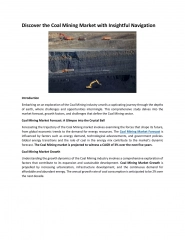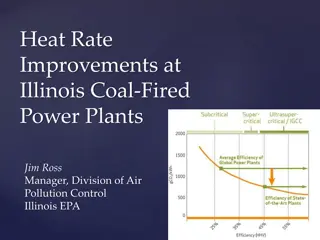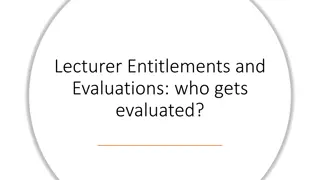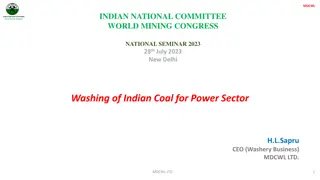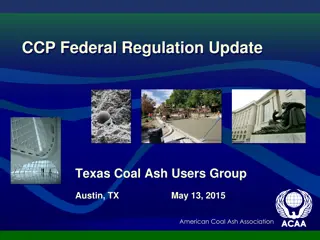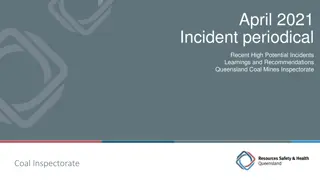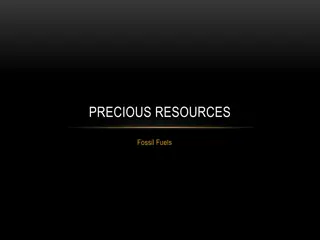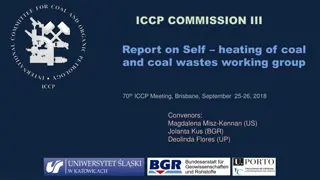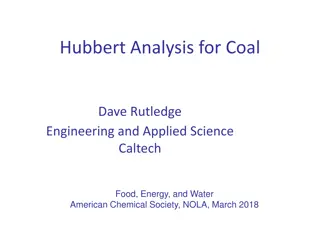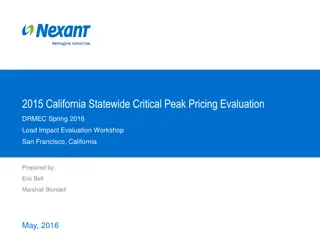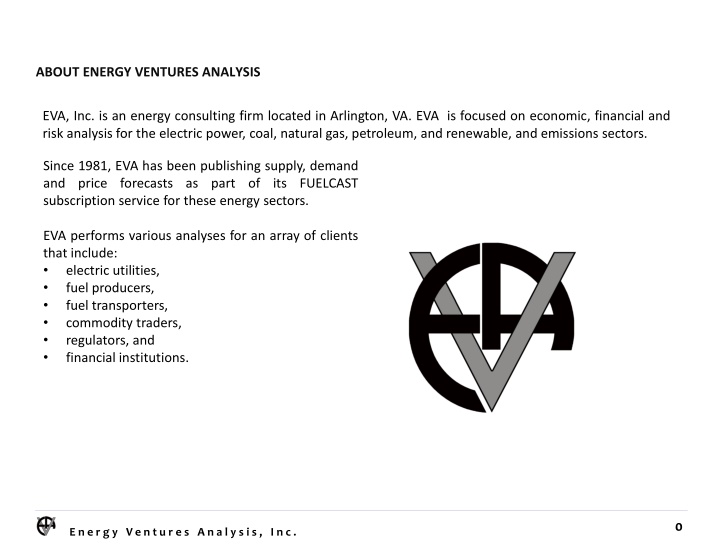
Energy Ventures Analysis - Expert Energy Consulting Firm in Arlington
EVA, Inc. is an energy consulting firm in Arlington, VA, specializing in economic, financial, and risk analysis for various energy sectors. They provide in-depth analyses for clients in the electric power, coal, natural gas, petroleum, renewable, and emissions sectors. EVA has extensive experience in assessing the impacts of regulations on the energy market, such as the Clean Power Plan. The firm also offers subscription services for supply, demand, and price forecasts in the energy sectors.
Download Presentation

Please find below an Image/Link to download the presentation.
The content on the website is provided AS IS for your information and personal use only. It may not be sold, licensed, or shared on other websites without obtaining consent from the author. If you encounter any issues during the download, it is possible that the publisher has removed the file from their server.
You are allowed to download the files provided on this website for personal or commercial use, subject to the condition that they are used lawfully. All files are the property of their respective owners.
The content on the website is provided AS IS for your information and personal use only. It may not be sold, licensed, or shared on other websites without obtaining consent from the author.
E N D
Presentation Transcript
ABOUT ENERGY VENTURES ANALYSIS EVA, Inc. is an energy consulting firm located in Arlington, VA. EVA is focused on economic, financial and risk analysis for the electric power, coal, natural gas, petroleum, and renewable, and emissions sectors. Since 1981, EVA has been publishing supply, demand and price forecasts as part of its FUELCAST subscription service for these energy sectors. EVA performs various analyses for an array of clients that include: electric utilities, fuel producers, fuel transporters, commodity traders, regulators, and financial institutions. 0 E n e r g y Ve n t u r e s A n a l y s i s , I n c .
EVAS EXPERIENCE ANALYZING THE CLEAN POWER PLAN EVA has a long history of assessing the impacts of various regulations on the energy sector including: Mercury & Air Toxic Standard (MATS) 316 B Cooling Tower Intake Structures Coal Combustion Residual Rule Cross State Air Pollution Rule/Clean Air Interstate Rule Regional Programs (RGGI, California AB32) Regional Haze State legislation (e.g. Colorado Clean Air-Clean Jobs , Illinois Multi-Pollutant Standard) State Renewable Portfolio Standards Since the EPA first announced the Clean Power Plan in June 2014, EVA has provided comprehensive analyses to various energy market participants including: Duke Energy Peabody Energy National Mining Association American Coalition for Clean Coal Electricity Southern Power North American Electric Reliability Corporation (NERC) 1 E N E R G Y V E N T U R E S A N A LY S I S, I N C.
STATE OF THE COAL MARKET U.S. coal production is expected to decline about 10% in 2015. Every supply region is affected. Additional declines are expected in 2016 and 2017. U.S. COAL SUPPLY (MILLION TONS) 2014 2015 2016 2017 2018 Total Supply 132.0 118.2 115.1 114.2 120.5 Northern Appalachia 116.3 96.9 88.4 86.9 89.6 Central Appalachia 16.6 14.8 14.4 14.1 14.2 Southern Appalachia 136.8 131.2 123.9 123.7 133.5 Illinois Basin 418.2 392.1 364.6 360.2 377.8 Powder River Basin 70.9 59.3 59.1 58.5 57.8 Rockies 103.2 993.9 89.5 902.1 97.4 862.9 99.0 856.5 99.0 892.4 Lignite and Other U.S. Production 1,019.2 25.3 23.0 925.1 24.3 887.2 22.7 879.2 24.7 917.1 Import, PC, Waste Total Supply The current market is the perfect nightmare for coal producers Low natural gas prices are causing natural gas-fired generation to displace coal fired generation in the power sector Compliance with the Mercury and Air Toxics Standard (MATS) is causing significant retirements of coal-fired plants The strong U.S. dollar has caused U.S. dollar-denominated global coal prices to fall which has largely made U.S. coals uneconomic in the global market. China s economic woes combined with the devaluation of the Renminbi has caused reduced imports by China as the devaluation has made imports relatively more expensive than domestic Chinese production. 2 E N E R G Y V E N T U R E S A N A LY S I S, I N C.
EPA CLEAN POWER PLAN Final Rule issued on August 3, 2015 and published in Federal Register on October 23, 2015 Uses EPA s authority under Section 111(d) of the Clean Air Act to regulate emissions from existing power plants Set state-specific CO2 mass- and rate-based emission limitations that states must achieve beginning in 2022. The rule applies to 3,056 qualifying fossil-fired generating units based on the following criteria: Commenced construction prior to January 8, 2014 Design power boiler heat input >250 MMBtu/hour Delivers >1/3 of potential power output to grid These qualification criteria exempt over 17,400 other existing generating units from the EPA Clean Power Plan 3 E N E R G Y V E N T U R E S A N A LY S I S, I N C.
EPA CLEAN POWER PLAN States must develop State Implementation Plans (SIPs) that meet CO2 emission limitations and are enforceable Initial state plans due by September 2016 unless extension granted Final state plans due by September 2018 If states fail to submit a plan, they will be subjected to already-created Federal Implementation Plan (FIP) States are given the option to develop either a rate-based or mass-based approach EVA believes most states are likely to adopt a mass-based compliance strategy because it is easier and less resource-intensive to implement and enforce PENNSYLVANIA RATE TARGETS PENNSYLVANIA MASS TARGETS lbs/MWh 000 tons 135 1,800 120 1,600 105 1,400 90 1,200 75 1,000 60 800 45 600 30 400 15 200 0 0 2012 Proposed Final 2012 Proposed Final 4 E N E R G Y V E N T U R E S A N A LY S I S, I N C.
EPA CLEAN POWER PLAN EPA developed final state emission rate and mass limitations applying 3 Building Blocks considered by EPA to be the Best System of Emission Reduction (BSER) under section 111(d) Building Block 1: Coal unit process efficiency improvements reduced from 6% to 4.3%, 2.1%, and 2.3% for the East, the West, and TX, respectively. The change reflects the lack of rigor in developing the 6%. The lower numbers are not supportable either. Building Block 2: Regional interconnect gas re-dispatching based upon 75% capacity of summer capacity Building Block 3: Additional clean energy production (Renewables) allowed from new nuclear Other changes include Elimination of Building Block 4 (energy efficiency) but energy efficiency is a compliance strategy Delay of initial compliance to 2022 from 2020 Updated method to calculate source-specific emission performance rates which caused CO2 targets to be redistributed among states. Some states affected more than others by this change. Ability to comply through interstate trading of allowances without formal regional alliances Inclusion of specific provisions to prevent leakage, i.e., compliance through new plant additions. States have the option to include new plants in their SIPs. (a) 5 E N E R G Y V E N T U R E S A N A LY S I S, I N C.
EPA CLEAN POWER PLAN The resulting emission standards are not based upon the ability of each category to actually achieve these rates using emission control technology or operational practices that power plants can implement at the facility. Rather, compliance with the standards requires states to develop individual plans for achieving the emission standards, all of which require significant reductions in coal-fired generation. EPA s impact analysis also changed Lower electricity demand growth which effectively incorporates Building Block #4 into the baseline Revised baseline showing significantly less coal generation, significantly more renewable The revised baseline results in lower impacts The revised baseline also means if the baseline generation is higher, the emission reduction requirements will be greater Generation (Billion KWH) Base Case - EPA Proposed CPP Base Case - EPA Final CPP Revised Base Case vs Original Base 2016 1,577 1,139 784 278 256 4,060 2018 1,654 1,082 820 279 282 4,143 2020 1,648 1,158 817 280 299 4,227 2025 1,683 1,263 817 280 335 4,404 2030 1,648 1,454 797 280 350 4,557 2016 1,335 1,339 767 283 316 4,057 2018 1,389 1,293 764 284 388 4,136 2020 1,448 1,209 798 310 406 4,190 2025 1,410 1,327 799 340 436 4,328 2030 1,443 1,411 783 340 473 4,467 2016 -15.3% -16.0% -12.1% -16.2% -12.4% 17.6% 19.5% 4.4% -2.2% -6.8% -2.3% -2.2% -1.8% 1.8% 1.8% 10.7% 21.4% 21.4% 23.4% 37.6% 35.8% 30.1% 35.1% -34.6% -30.8% -24.0% -38.5% -39.3% -0.1% -0.2% -0.9% -1.7% -2.0% 2018 2020 2025 2030 Coal Gas/Oil Nuclear Hydro Other Renewables Other TOTAL 5.1% -3.0% 26 26 25 26 28 17 18 19 16 17 6 E N E R G Y V E N T U R E S A N A LY S I S, I N C.
SUMMARY OF FINDINGS U.S. Implementation of the Clean Power Plan will result in declining demand for coal in the power sector due to its emission intensity relative to competing fuels Power Sector Coal Demand MM tons 1,000 BAU CPP - Mass CPP - Rate 900 800 700 Long-term coal demand trends will be heavily dependent on whether states opt for mass- vs. rate-based compliance strategies, as shown in the chart 600 500 400 300 200 100 - Compared to a Business as Usual (BAU) baseline, total coal demand is expected to decline by 24% and 58% under a mass- and rate-based regimes, respectively. 2020 2025 2030 EVA s analysis suggests that between 2022 and 2030, the mass- and rate-based regimes will respectively result in nearly a cumulative loss in coal demand of 1.2 billion and 3.2 billion tons. 7 E N E R G Y V E N T U R E S A N A LY S I S, I N C.
SUMMARY OF FINDINGS WHOLESALE ENERGY PRICE IMPACTS Wholesale energy prices represent marginal fuel plus variable operating and maintenance costs including allowances. PJM West Wholesale Energy Prices $/MWh $80 Business as Usual CPP - Mass CPP - Rate $70 $60 Wholesale energy prices are expected to be higher under both CPP scenarios compared to a Business as Usual case $50 $40 $30 $20 The major drivers of higher energy prices are elevated natural gas prices and environmental compliance costs. $10 $0 2020 2025 2030 Average wholesale energy prices by 2030 are expected to be 12% and 20% higher in the mass- and rate- based scenarios, respectively, compared to the Business as Usual scenario Consumer cost impacts would likely be greater because of additional capital requirements under CPP. 8 E N E R G Y V E N T U R E S A N A LY S I S, I N C.
DEMAND SIGNIFICANT PLANT RETIREMENTS HAVE ALREADY OCCURRED Since 2010, there have been significant retirements of coal capacity in Pennsylvania. Retirements include: Martins Creek Cromby and Eddystone Elrama Hatfields Ferry Mitchell Portland Pennsylvania Coal Plant Retirements (MW) 2,000 6,000 1,800 5,000 1,600 1,400 4,000 1,200 1,000 3,000 800 2,000 600 400 1,000 200 Primary reasons for closure in last five years were MATS compliance costs and PJM capacity payments 0 0 2002 2003 2004 2005 2006 2007 2008 2009 2010 2011 2012 2013 2014 2015 Retirements Cumulative Retirements This capacity represents 10 to 15 million tons per year of lost Pennsylvania coal demand potential. 9 E N E R G Y V E N T U R E S A N A LY S I S, I N C.
DEMAND TOP 20 CONSUMERS OF PENNSYLVANIA COAL IN 2014 PA Tons 5,460,731 2,693,110 2,620,017 2,602,873 2,594,951 2,404,530 2,210,011 2,054,759 1,527,336 1,480,528 1,324,518 1,301,758 1,226,938 1,139,354 1,069,936 1,015,715 969,728 751,010 732,325 727,468 Total Tons 5,700,867 2,693,110 5,351,619 4,559,176 4,315,055 4,467,893 2,489,737 2,298,943 1,738,749 7,325,724 3,049,449 3,622,222 2,766,057 3,802,865 2,827,402 1,021,870 1,096,865 2,731,652 4,344,329 934,959 PA 20 plants accounted for about 75% of utility purchases of Pennsylvania coal in 2014. Plant Homer City Generating Station Seward Waste Coal (PA) Belews Creek Conemaugh Fuels LLC Cross Keystone Fuels LLC Morgantown Generating Station Brandon Shores Longview Power LLC FirstEnergy Bruce Mansfield Elm Road Generating Station Roxboro FirstEnergy W H Sammis Mt Storm PPL Montour Shawville Chalk Point LLC PPL Brunner Island Cardinal Avon Lake State PA PA NC PA SC PA MD MD WV PA WI NC OH WV PA PA MD PA OH OH Share 95.8% 100.0% 49.0% 57.1% 60.1% 53.8% 88.8% 89.4% 87.8% 20.2% 43.4% 35.9% 44.4% 30.0% 37.8% 99.4% 88.4% 27.5% 16.9% 77.8% Only two of the plants (Shawville and Chalk Point) have announced retirement dates. In-state plants account for just over 50% of the top 20 Compliance strategies in other states also impact demand for Pennsylvania coal. 10 E N E R G Y V E N T U R E S A N A LY S I S, I N C.


